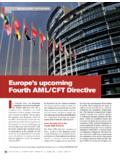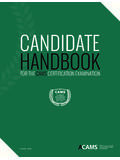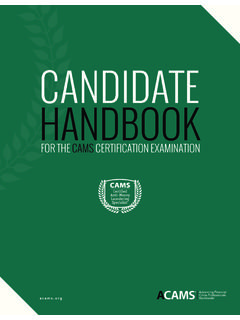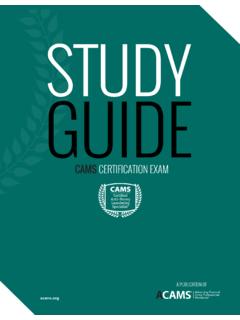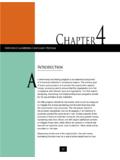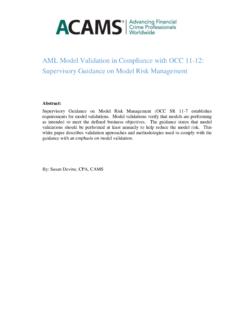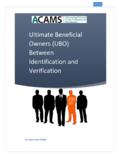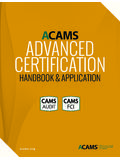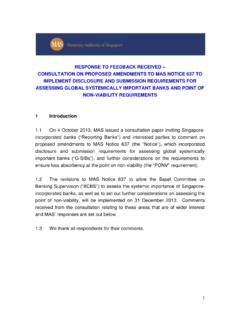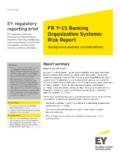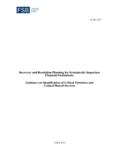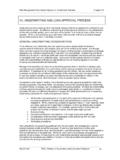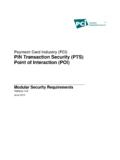Transcription of The Importance of AML Model Governance and Validation
1 The Importance of AML Model Governance and Validation Andrew Li The Importance of AML Model Governance and Validation Introduction .. 3 Regulatory 4 Overview .. 6 Model Governance .. 8 Model development, implementation and use .. 9 Model Validation .. 11 Conclusion .. 12 Introduction With the technological advancement, the high complexity of the banking industry and the broader application of modeling, financial institutions (FIs) around the world are relying heavily on quantitative analysis models to make predictions within the risk tolerance. These include models on analysis from underwriting credits to the anti-money laundering (AML) program. Due to the increasing numbers of risk models being used by FIs, regulators have correspondingly increased focus on the tighter requirement of robust AML models, including Model Validation and quantitative analysis.
2 As a result, regulators have shifted their focus to Model examinations. For example, the OCC1 has employed more staff at their Risk Analysis Division on Model testing. Moreover, with the adversity of recent regulatory breaches, regulators have a high expectation that all FIs should develop complex AML programs with sound measures to effectively manage Model risk. As a result, multiple regulatory guidance has been issued which has affected the FI s overall administration on the AML program. As an auditor, it is now paramount to be able to perform audit and Validation on the AML risk Model . For example, as part of the regulatory guidance issued in 2011 jointly by the OCC and the Federal Reserve, the Supervisory Guidance on Model Risk Management (OCC2011-12)2 requires independent audit to ascertain that the AML Model is validated, meaning it is functioning effectively and efficiently as designed.
3 Thus, auditors should be familiar with the components of the models, its requirements and steps to validate the Model . As such, the auditor should have the expertise to address or ascertain the following to validate the Model : Clearly documented approach and consistent methodology to Model risk management; Model risk management should be aligned with the enterprise-wide Model risk management policies or practices; The documented approach required to validate the AML models; Ascertain that the alert/filtering level quality is configured appropriately; and 1 Office of the Comptroller of the Currency (OCC) 2 The supervisory guidance on Model risk management, issued in April 2011, was developed jointly by the Office of the Comptroller of the Currency and the Board of Governors of the Federal Reserve System.
4 Whether default parameter values in the AML models configured by the vendor are appropriate or require additional tuning. This white paper will discuss the rationale on the requirement of a sound Model risk management, the key components/requirements of a risk Model , as well as key items to watch for during Model Validation . Regulatory Requirement For the last few years, as a result of the large number of regulatory breaches from the failure caused by ineffective AML programs that lead to fine and penalties, there has been increasing regulatory requirements put forth for FIs, to ensure that AML Model risks are at an acceptable risk level, including regulatory guidance that has a direct impact on the FI s overall administration on the AML program.
5 For example, in April 2011, the OCC had issued supervisory guidance on Model risk management, 3 which requires FIs to conform to the principles on risk Model development, implementation, use and Validation . Since then, regulatory agencies have shifted their resources and focus to assessing how institutions Model their transaction monitoring programs. These regulatory agencies now perform examinations that go beyond a regular audit that requires specific evaluation on the risk Model , and are instead seeking to assess effective management of risks that arise when using quantitative models in decision-making. Noncompliance of the guidance may lead to fines, penalties and/or enforcement actions.
6 For example, in 2012, the OCC issued a Consent Order4 to Citibank for its deficiencies in the FI s BSA/AML compliance program, in particular weaknesses in the AML Model risk management. Furthermore, in December 2015, NYDFS5 announced a proposed new AML regulation (Section 504),6 that requires FIs that are chartered or licensed under the New York banking Law to have more responsibilities, including a robust transaction monitoring (TM) system, a watch-list filtering program, and that the chief compliance officer certify that the FI has sufficient programs in place to comply with the regulation, on an annual basis. The NYDFS proposed regulation (Section 504), currently seeking comments from the general public until March 31, 2016, is resulted from a series of investigations conducted by the NYDFS over the last few years.
7 The investigation discovered numerous deficiencies on the breach of 3 The guidelines were adopted by the OCC as Bulletin 2011-12 and by the Federal Reserve as FRB SR 11-7. The new OCC bulletin supersedes OCC Circular 2000-16, which focused primarily on an independent and comprehensive Model - Validation function. 4 In Apr 2012, Citibank, , has entered into a Consent Order with OCC regarding certain deficiencies relating to its Bank Secrecy Act/Anti-Money Laundering 5 the New York State Department of Financial Services 6 GOVERNOR CUOMO ANNOUNCES ANTI-TERRORISM REGULATION REQUIRING SENIOR FINANCIAL EXECUTIVES TO CERTIFY EFFECTIVENESS OF ANTI-MONEY LAUNDERING SYSTEMS, The proposal is seeking comments from public until 31 Mar 2016.
8 The NYDFS press release and Proposed Rule are available at: AML and sanctions compliance, in particular on transaction monitoring and filtering, and a lack of accountability at the senior levels. As a result, a regulation is needed to address these issues. Under the NYDFS proposed regulation (Section 504), every FI regulated under NYDFS must maintain a robust transaction monitoring system to monitor transactions on AML violations and suspicious activities. If the proposed regulation goes through, other regulators will most likely follow. The proposed regulation (Section 504) has various requirements, including the control of risk Model on transaction monitoring program. Some of the key attributes required under the proposed regulation are:7 The program must be based on the risk assessment of the FI, and matched to the FI s business, products, services and customers; The system settings and detection scenarios must be designed to reflect the FI s AML risk assessment, CDD information and other information from areas such as security, investigations and fraud prevention; There are documentation describing the FI s current detection scenarios with its associated assumptions, rule setting and parameters; Ongoing analysis of the continued relevancy of parameters, thresholds and other settings.
9 And FIs are prohibited from changing or altering the AML Model to lower the alerts to avoid filing SARs. Most importantly, the chief compliance officer, under the proposed regulation, is required to certify that the TM program meets all regulatory requirements on an annual basis, which is a regulatory requirement that is even more stringent than the AML regulations currently prescribed by the federal government. This places a lot of burden on the compliance officers, as any noncompliance of the proposed regulation may subject them to criminal penalties. In view of these heightened regulatory requirements, FIs are scrambling to review their AML models (such as transaction monitoring, sanctions filtering) to ensure they are in compliance.
10 FIs also need to ensure the AML models cover accurate and relevant risk exposures matching the FI s risk profile and appetite. 7 GOVERNOR CUOMO ANNOUNCES ANTI-TERRORISM REGULATION REQUIRING SENIOR FINANCIAL EXECUTIVES TO CERTIFY EFFECTIVENESS OF ANTI-MONEY LAUNDERING SYSTEMS, The NYDFS press release, 1 Dec 2015 key attributes of the proposed regulations Overview As the FI industry becomes more and more complex, coupled with the advanced technological breakthroughs, FIs around the world are increasingly relying more on mathematical models to make business decisions, as well as to meet regulatory requirements. Nevertheless, the risk inherent in these models, or so called Model risk, has drawn concerns among regulators.

